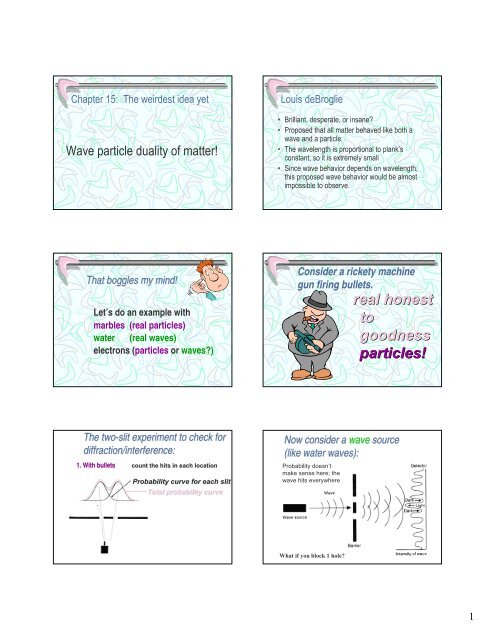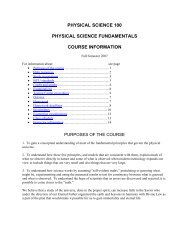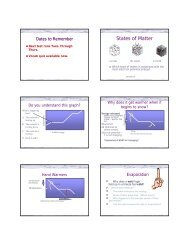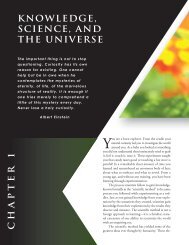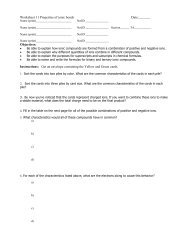Chapter 15 - Physical Science 100
Chapter 15 - Physical Science 100
Chapter 15 - Physical Science 100
You also want an ePaper? Increase the reach of your titles
YUMPU automatically turns print PDFs into web optimized ePapers that Google loves.
<strong>Chapter</strong> <strong>15</strong>: The weirdest idea yetWave particle duality of matter!Louis deBroglie• Brilliant, desperate, or insane?• Proposed that all matter behaved like both awave and a particle.• The wavelength is proportional to plank’sconstant, so it is extremely small• Since wave behavior depends on wavelength,this proposed wave behavior would be almostimpossible to observe.That boggles my mind!Let’s do an example withmarbles (real particles)water (real waves)electrons (particles or waves?)Consider a rickety machinegun firing bullets.real honesttogoodnessparticles!The two-slit experiment to check fordiffraction/interference:1. With bullets count the hits in each locationProbability curve for each slitTotal probability curveNow consider a wave source(like water waves):Probability doesn’tmake sense here; thewave hits everywhereWhat if you block 1 hole?1
Electrons• Need slits about the size of electron wavelength.• If deBroglie’s right, slits need to be about 10 -10 m.• How do you make a slit that small?– You don’t. You use the space between atoms in acrystal.‘slits’ madeby atoms in acrystalElectrons - real, honest-togoodnesswhat?An electron gun like the one in any TV set.But what if you send the electronsthrough 1 at a time?• Each electron makes a spot on thescreen.• The cumulative effect of manyelectrons is the same interferencepattern.The wave nature of the theelectron means a differentpattern for one slit vs. two,even when shot one at atime!So, electrons, likephotons, areschizophrenic.Wave-ParticleDualityNobel laureates for quantum mechanicson quantum mechanics:• Physics is very muddled again at the moment; it is much too hard forme anyway, and I wish I were a movie comedian or something likethat and had never heard anything about physics!Wolfgang Pauli (1900-1958) Austrian Physicist in the US. (Nobel Prize,1935). From a letter to R. Kronig, 25 May 1925.• I do not like it, and I am sorry I ever had anything to do with it.Erwin Schrödinger (1887-1961) Austrian physicist. Nobel Prize, 1933.Speaking of quantum mechanics• If I had my life to live over again, I'd be a plumber.Albert Einstein• If somebody says that he can think about quantum physics withoutbecoming dizzy, that shows only that he has not understood anythingwhatever about it.Niels BohrHow do we picture it?“Electrons or photons arrive in lumps, likeparticles, but the probability of arrival ofthese lumps is determined as the intensity ofwaves would be. It is in this sense that theelectron behaves sometimes like a particleand sometimes like a wave.”“I think I can safely say that nobodyunderstands quantum mechanics.”Richard FeynmanNobel Prize, 19652
Trying to Fool Mother Nature• What hole does the electron go through?– there is a probability of either• What if I detect the electrons going throughthe holes?– They will go through one hole or the other– The interference pattern goes away; I get aparticle patternQuestions &Answers (?)ObservationPointQ. What is seen at the observation point with both holes open?A. No electrons!Q. If I close one hole?A. Suddenly, electrons!Q. Where are they coming from?A. The open hole!Q. If I open the second hole?A. There are no electrons any more?Q. How can it be like that??No one knows!Probability CurveWhen we look at the electron ...it acts like a particle–When we’re not looking, like a wave.How do we “look”? Must use a detector or probe whichinteracts with the electron.e.g. light… but a photon is like a bomb to an electron!- like trying to see the trajectory of a baseball by hitting itwith grenadesMaking the measurement affects the result!3
“More Quantum Wierdness”Joke• Heisenberg is driving along when he gets pulledover by a cop.• The officer comes up to the window and asks, sirdo you have any idea how fast you were going.• No says Heisenberg, but I know where I am.Uncertainty Principle in MathThe uncertainty in position times the uncertainty inmomentum (mass x velocity) is greater than Planck’sconstant.∆x ∆(mv) > hsignificant for electrons and their ilk[This is not a measurement problem, but a statement offundamental limitations in nature.]Heisenberg Uncertainty Principle• To know a particle’s motion we must know its positionand velocity at the same time.• But how do you locate the position of a wave/particleelectron?Pure sine wave no positionbut clear wave properties.Sharp pulse clear positionbut unclear wave properties.consequences• If I try to find out where an electron is, I knowless about where it is going.– Measuring position more accurately makesuncertainty in momentum larger.• The converse is not true – being sloppy aboutposition measurements doesn’t magically impartknowledge about velocity.If I pass electrons through a slit and make the slitnarrower, what does narrowing the slit tell us abouttheir position?1. The narrower the slit, the better theirposition is known when they passthrough2. Narrowing the slit doesn’t revealanything about position3. Narrowing the slit will increase thenumber observed at the detector4
If I pass electrons through a slit and make the slitnarrower, what happens to their momentum in thedirection you narrow the slit?If I pass electrons through a slit and make the slitnarrower, what happens to the width of thedistribution at the detector screen?1. The narrower the slit, the better theirmomentum is known when they passthrough2. Narrowing the slit doesn’t revealanything about momentum3. Narrowing the slit will lead toincreased uncertainty in momentum1. The narrower the slit, the narrowerthe peak on the screen2. Narrowing the slit won’t affect thewidth of the peak3. Narrowing the slit will lead to abroader peak on the screen5


